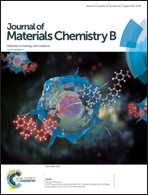Comprehensive study on cellular morphologies, proliferation, motility, and epithelial–mesenchymal transition of breast cancer cells incubated on electrospun polymeric fiber substrates†
Abstract
The progress of microenvironment-mediated tumor progression in an artificial extracellular matrix explores the design criteria to understand the cancer progression mechanism and metastatic potential. This study was aimed at examining the combination of both surface topographies (fiber alignments) and different stiffness of polymeric substrates (PLLA and PCL) to evaluate the effects on the cellular morphologies, proliferation, motility, and gene expression regarding epithelial to mesenchymal transition (EMT) of two different types of breast cancer cells (MDA-MB-231 and MCF-7). The cellular morphologies (roundness and nuclear elongation factor), E-cadherin and vimentin expression, and cellular motility in terms of cellular migration speed, persistent time, and diffusivity have been comprehensively discussed. We demonstrated that the microenvironment of cell culture substrates influences cancer progression and metastatic potential.



 Please wait while we load your content...
Please wait while we load your content...